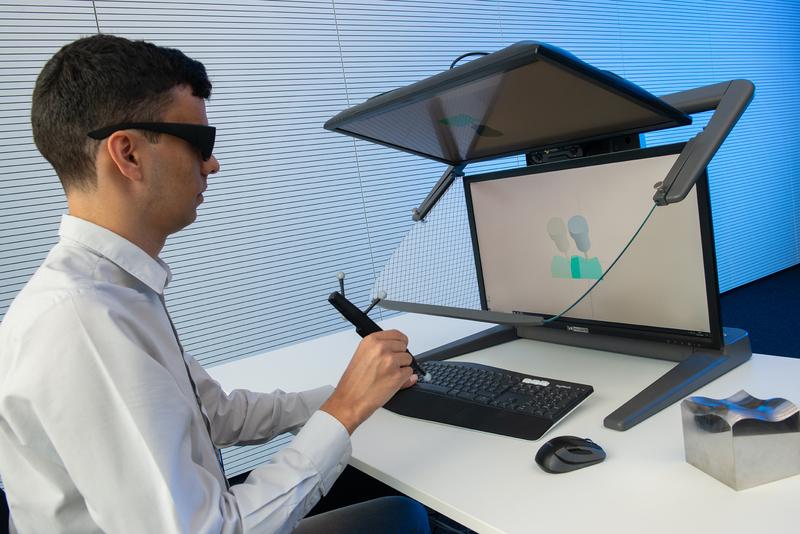Let’s try it! Planning tool paths for machining processes in CAM systems requires in-depth expert knowledge. A large number of parameters must be determined and checked in order to optimize the path planning step by step. In order to…
Cameras in the stereo screen capture the movement, and the screen uses the stereoscopic effect to create a 3D image to display the input, the tool and the workpiece in real time.
© Fraunhofer IPT
Let’s try!
Planning tool paths for machining processes in CAM systems requires in-depth expert knowledge. A large number of parameters must be determined and checked in order to optimize the path planning step by step. To make this time-consuming task easier in the future, the Fraunhofer Institute for Production Technology IPT in Aachen, together with partners, has created an AI-supported virtual reality environment for gesture input in which the tool paths can be intuitively sketched on the workpiece surface.
Tool paths for CNC machine tools are now planned using CAM software that takes a variety of CAM parameters into account. These parameters tell the CAM system how the exact tool path is generated before the tool path is passed on to the machine control system. The more complex a component is, the more extensive and error-prone the description of the tool path is. Good CAM programming therefore requires a high level of expertise, because only very trained and experienced workers can correctly estimate the result quickly and without countless time-consuming iterations. More often, many different parameters have to be tried out in several passes until the tool follows the optimal path.
The research team at Fraunhofer IPT, together with its industrial partners, would like to reduce this effort in the future: In the «CAMStylus» project, the team worked on making the planning of tool paths in CAM systems more intuitive using a virtual reality (VR) application. The VR application in combination with specially developed hardware allows users to describe tool paths in three dimensions using gesture control. The system then uses the recorded gestures to calculate the CAM parameters that are used in the CAM system to calculate the tool path.
CAMStylus: Mark the path with the pen in your hand
In the first phase of the project, the researchers at Fraunhofer IPT developed the VR environment and programmed suitable software for tracking gestures that describe the path movements. The combination of hardware and software makes it possible to record the movements of so-called tracking pens, which were developed in the project.
In order to derive the correct information for the intended tool path from the motion tracking data, the research team relies on an AI application based on neural networks that were trained for this task using specially designed geometric bodies. A particular challenge in software development was to repeatedly compare the CAM data with the data recorded by the tracking system in order to have a reliable database for later calculations.
Voxel representation to describe the gestures
The VR application uses a stereo screen to create the 3D effect. The gestures can be entered using the tracking stylus. The recorded positions and orientations of the input device are displayed in real time in the VR application, providing direct feedback on the entered gesture. The system then converts the data into a voxel representation from which the artificial intelligence recognizes the essential features of the gesture. The software then calculates the tool path based on the recognized features. This can be used, as in conventional CAM systems, to simulate, examine and carry out the process.
Successful finishing of test components
For testing purposes, the Fraunhofer IPT team successfully used the CAMStylus system to plan finishing operations on a real test geometry at WBA Aachener Werkzeugbauakademie GmbH.
The project results point the way for further research and development projects with industrial partners. They are now being presented in scientific publications and conferences and will be further developed in the future in the various user communities of the Fraunhofer IPT with partners. A first publication entitled «Intuitive toolpath planning in computer-aided manufacturing systems using artificial intelligence in a virtual reality environment» will be published this year as part of the 17th CIRP-ICME conference.
Project partners
– ModuleWorks GmbH, Aachen (project coordination)
– Fraunhofer Institute for Production Technology IPT, Aachen
– Schneider Digital Josef J. Schneider e. K.
– WBA Aachener Werkzeugbauakademie GmbH, Aachen
Funding information
The research project “CAMStylus – Development of an AI-supported virtual reality solution for the intuitive operation of computer-aided manufacturing systems” is funded by the Federal Ministry of Education and Research (BMBF) (funding code: 01IS22006D).
Scientific contacts:
Philipp Ganser, M.Sc.
Fraunhofer Institute for Production Technology IPT
Phone +49 241 8904-425
philipp.ganser@ipt.fraunhofer.de
www.ipt.fraunhofer.de
Additional Information:
https://www.ipt.fraunhofer.de/de/presse/Pressemitteilungen/20240712-werkzeugbahn…
Media Contact
Susanne Krause External and internal communication
Fraunhofer Institute for Production Technology IPT
All news from the category: Information Technology
Innovations and developments in the areas of information and data processing as well as the hardware required for this can be found here.
Among other things, you will receive information from the following sub-areas: IT services, IT architecture, IT management and telecommunications.




